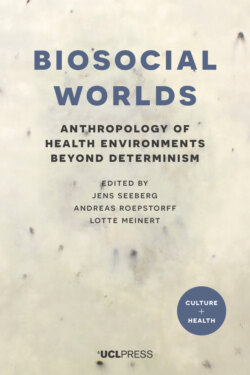Читать книгу Biosocial Worlds - Группа авторов - Страница 9
На сайте Литреса книга снята с продажи.
Introduction
ОглавлениеJens Seeberg, Andreas Roepstorff and Lotte Meinert
Anthropological explorations of the worlds we live in have systematically destabilised the boundary between nature and culture that once served as a founding dichotomy of anthropology as a discipline. Not only has the idea of nature as a domain that can exist outside the reach of the impact of (human) culture been challenged by the massive impact of humanity on the global ecosystem, as reflected in the labelling of our current geological epoch as the Anthropocene, it has also become increasingly clear that the ability to produce culture is not an exclusively human capacity. Indeed, the anthropological concept of culture can no longer ignore ‘cultivation practices in non-human cultures, such as ants, that go back hundreds of millions of years’ (Lien et al. 2018, 16). Furthermore, as Palsson has pointed out, life itself has become unstable in a range of ways (Palsson 2016). Body parts and organs are augmented or replaced with implants. Organs travel from one body to the next and from one species to another. The renewed importance of the field of epigenetics, as well as the unfolding exploration of the human microbiome, increasingly unsettles old constructs of the individual, highlighting permeability and relationality between organisms and between organism and environment. These and related developments in our understanding and production of life have led to a suggestion to replace the notion of ‘human being’ with one of ‘human becoming’ (Ingold 2013).
Such changes and insights call for a repositioning of anthropology vis-à-vis biology, as they seem to open new possibilities for both disciplines. Biodeterminism – the assumption that life is genetically predetermined or inscribed – no longer upholds the status of dominant scientific paradigm among biologists. Keller, for example, has pointed to the long history of the nature–nurture debate and its refusal to die (Keller 2010). Yet the debate thrives from the continuous production of new data in one camp that ought to convince members of the other camp, and she argues that semantic difficulties have contributed significantly to driving the disagreement. Importantly, Keller points to the mirage of a space between nature and nurture and, tracing the expression back to Galton, asserts that attempting to replace genetic determinism on the one hand with a similarly reductionist opposite of social determinism on the other would lead nowhere (Keller 2010). However, as noted by Lewontin and many others, some very real effects emerged from this ‘mirage of a space’: the separation of the natural and the social had opened the space in which deterministic ‘projections’ could be cast in both directions between the two, each constituting a Platonic screen for the other (Lewontin 1993). Latour pointed out this model in his critique of the social sciences, highlighting the projection of the social onto the natural (Latour 1993), but, we argue, the reverse projection is equally problematic.
Thus, this volume brings together state-of-the-art contributions to critical anthropological thought around the social and biological as well as ethnographic explorations of human and non-human life in the light of changing understandings of biology.
